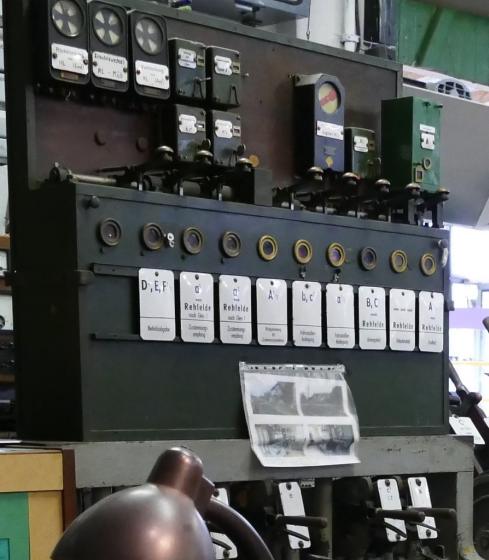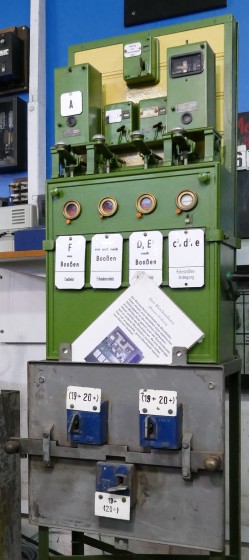Here is the next posting from Letschin, with pictures by Robert Herzog. We will see a number of mechanical lever frames, and interestingly, the ubiquitious German Einheit frame will get only a handful of pictures—most of the frames are of older types.
The first one, however, is an Einheit frame, originating from the dependent signal box at Rotes Luch. On the left side of the frame, one can see a signal crank (they are used for signals that are far away from he signal box), then there are standard single levers, and in between a double lever for a three-aspect semaphor. Above the frame lock, there are two newer key locks, and on the far right there is a route lever reused as a signal lever, with additional lever locks. Behind the frame, one can see the block instruments. Below them, there are the route levers, while above them one can barely see a few repeaters:
"Einheit" frame originally at dependent signal box Rotes Luch, railway museum Letschin, 2020
Here is another photo of this frame, behind a table with various telephones:
Telephone, "Einheit" frame originally at dependent signal box Rotes Luch, railway museum Letschin, 2020
This enlargement from the previous image shows the plates and additional devices above the block instruments in more detail:
"Einheit" frame originally at dependent signal box Rotes Luch, railway museum Letschin, 2020
The next frame is, once more, an "Einheit" frame. This one is from block post Obersdorf (b. Müncheberg):
"Einheit" frame originally at block post Obersdorf (b. Müncheberg), railway museum Letschin, 2020
But let's now look at some older frames. The first one is of type Jüdel 6000, most probably from Saxonia. The first picture shows the complete frame, with the typical German arrangement of the Siemens block instruments and the route levers on the left and the signal and points levers on the right. In contrast to "Einheit" frames, the signal levers are here far away from the block instruments, which probably requires long signal sliding bars:
Jüdel 6000 frame, railway museum Letschin, 2020
The route levers are almost vertical, with rods reaching down into the housing of the block sequence locks:
Jüdel 6000 frame, railway museum Letschin, 2020
This image shows the lever frame from the other end. The first three levers are for signals, two of them have knobs at the end which is typical of older Jüdel frames. On the first lever, a lever lock was added later. To the left of the signal levers, there are points and FPL levers:
Jüdel 6000 frame, railway museum Letschin, 2020
Between the last two levers, there is a frame lock, and a route lever is lying around:
Jüdel 6000 frame, railway museum Letschin, 2020
The next frame is was built by Gast for the station of Spremberg, with levers of type Bruchsal J. Here are the block instruments and the route levers:
Gast originally at Spremberg, levers of type Bruchsal J originally at Forst (Lausitz), railway museum Letschin, 2020
Here are the route levers and the block sequence locks:
Gast originally at Spremberg, levers of type Bruchsal J originally at Forst (Lausitz), railway museum Letschin, 2020
This image has more details of the levers. One of them is a double levers for the FPL of points no.1:
Gast originally at Spremberg, levers of type Bruchsal J originally at Forst (Lausitz), railway museum Letschin, 2020
The following frame was built by Stahmer for the dependent signal box W25 at Leipzig main station:
Stahmer originally at Leipzig Hbf W25, railway museum Letschin, 2020
Stahmer originally at Leipzig Hbf W25, railway museum Letschin, 2020
Next one: Zimmermann & Buchloh, the frame is from Rehfelde:
Zimmermann & Buchloh originally at Rehfelde, railway museum Letschin, 2020
Also built by Zimmermann & Buchloh, this frame is from the signal box at Tiefensee:
Zimmermann & Buchloh originally at Tiefensee, railway museum Letschin, 2020
The next image shows the block instruments from Forst (Lausitz), which probably worked together with a key interlocking:
Line block instruments originally at Forst (Lausitz), railway museum Letschin, 2020
Here we see an unknown "Einheit" frame (or parts of it):
"Einheit" lever, railway museum Letschin, 2020
"Einheit" lever, railway museum Letschin, 2020
And finally, here is a host of levers and signal cranks from different German manufacturers, mounted on an Einheit frame:
Levers, railway museum Letschin, 2020
So much for another posting from Letschin—next time, you'll see a handful of electro-mechanical frames!


No comments:
Post a Comment